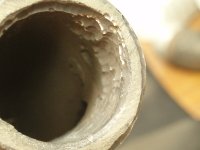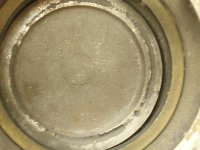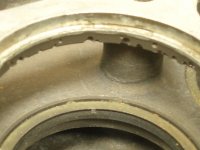I am a licenced HD mechanic I got my licence in 1973, I have rebuilt thousands of engines.
Look up DCA4 it is a coating not one official place does it say protectant.
Cat will not cover damage done by DCA4, the directional nozzles eaten away in the heads the valves cooling area coated and insulated till the head cracks. liners destroyed because they are coated with the green crap,and cracked, Blocks corroded threw the "O" ring sealing area, Thermostat housing eaten completely threw. water pump covers eaten away. Liners so badly corroded they are porous, Blocks damaged from corrosion on the deck at the water grommet area.
Cummins will not cover Injector tubes eaten away, water by-pass tubes eaten away from the inside out.
These things did not happen on systems that were not treated these were units and problems on units that had water filters and were regularly tested and serviced.
You call it a 'coating'. Nobody else does. It is a supplemental coolant additive like several others on the market. SCA is used to increase the cavitation pitting resistance in glycol coolants. SCAs are replaced on a service interval basis as they are sacrificial chemicals. The action of the nitrite and molybdate additives is to chemically combine with the iron oxide on the coolant side of the cylinder wall. This hard 'coating' is microscopic and is not visible. It behaves much like a 'Kevlar jacket' (bullet resistant). Cavitation bubbles implode against this oxide film and damage it rather than the iron below. This is why these additives in either liquid form or in replaceable coolant filters are part of a PM service.
DCA4 does not cause that damage. The way you state that makes sound like you are a Caterpillar mechanic. No engine company will pay for cavitation pitting failures. Failure to use engine coolants and supplemental coolant additives is a maintenance fault of the owner. Those products and many like them will reduce or prevent cavitation failures. The 'directional' nozzles you speak of must be the water directors that Caterpillar uses on their cylinder heads (8 1/2 years as a field service mechanic for Cat, 6 years as a training instructor, need I go on?) shows you are a CAT guy. Nothing wrong with that but again, your bias is clouding your ability to help somebody who was asking what to do...not asking for some diatribe against a competitor product. Look up my bio. I do not have bias when it comes to matters like this. Solid information and not personal prejudice is what is needed on these forums.
For the sake of others reading this as I do not expect to change your views, let me cover the failure modes you describe.
Your description of the failure mode is more related to the water used to make coolant. Hard water is very likely to form scale deposits on high temperature coolant passages in cylinder heads. Wherever there is boiling heat transfer, there will be deposit formation especially from hard water (lime or calcium carbonate). That is the result of too little use of an SCA as most of them have scale inhibitors.
Block damage in the lower block bore O-ring zone. Block damage is a broad statement. Typically, the block damage is due to fret wear as the lower liner does experience side to side movement thus rubbing the liner that is harder than the block surface. Tighter block to liner clearance will reduce that but that is not something that can be adjusted. It is a design issue.
Lower O-ring damage. That would be the top O-ring which actually is experiencing crevice erosion failure. Liner pits and shredded liner top o-rings are due to the lower end of the liner moving side to side as the engine runs. The top ring flexes and changes from a compressed oval back to a more round shape. This causes coolant to be pumped in behind the o-ring along with core sand and dirt causing high velocity particle abrasion. Close examination of those pits will show the surfaces to be more polished than cavitation pits which are rough and jagged as the cavitation damage follows the grain structure of the liner. Caterpillar engines experience this more than other other brands. I have seen this failure mode in Cummins, as well, but not nearly to the extent that Cat has this issue.
Thermostat housing 'eaten through': Must be aluminum. Cast iron does not have that issue. Many engines have aluminum thermostat housings. Aluminum in this area is particularly subject to issues with coolant flow velocity and the issues is amplified when the coolant mix has more water. Water and aluminum only work together really well when the application is an aluminum boat or a beer can, not as part of a cooling system.
The three pictures at the bottom of this post are from an aluminum thermostat housing damaged by high coolant velocity and poor quality coolant or lack of sufficient glycol content. These are not issues caused by SCA like DCA4 and other brands.
Aluminum water pump covers experience the same issues but it usually happens faster as the turbulence in that area is much greater than in the thermostat housings. Again, the real cause is insufficient glycol content and insufficient supplemental coolant additives. Not warrantable failures.
Your statement about cylinder liners being so badly corroded that they are porous shows that you have not learned what cavitation pitting is. The failure mechanism is cavitation erosion. Cavitation is the impact result of a coolant vapor bubble that collapses against the cylinder wall during the power stroke on a diesel engine. Two things working together cause this. The first is the pressure wave that passes through the cylinder wall into the coolant that lowers the coolant pressure adjacent to the cylinder wall and the second is the vibration of the liner as the piston skirt slaps the cylinder wall after the piston starts downward on the power stroke (about 13 degrees after TDC is typical when it happens). That vibration causes the liner to ring like a tuning fork. The coolant cannot constantly keep in contact with the cylinder wall thus coolant vapor bubbles are formed. They collapse onto the surface with a measured force of 15,000 to 20,000 PSI. A hydraulic sledge hammer blow to the liner. It is not corrosion. It is due to insufficient use of SCA like Pencool, Cat SCA additives, DCA4 and other brands. Chemically all of these have a lot in common. The failure to use them and keep their strength up is the cause of these issues.
The last issue you speak of is the fire deck damage under the rubber water grommet. You ARE a Cat guy!

That is called crevice corrosion and is due to stagnant coolant trapped under that grommet. The coolant becomes very acidic as there is no active coolant flow under the grommet. The acidic coolant corrodes the iron surface. It is the same failure mode on a Detroit Diesel copper injector cup and some other cups on other engines. Stagnant coolant trapped such that there is no active coolant flow to prevent coolant degradation. You always find this issue in high temperature areas of the engine like the cylinder head-to-block deck joint or the injector cups.
I do not doubt that you have seen these failures in four decades of service work. Your conclusion that DCA4 or any SCA causes these is wrong. Failure to use these chemical protectors on a regular basis and in sufficient amounts is the cause of many of these failures. The aluminum issues are more driven by lack of glycol content but not solely. As an example of this last statement, the DT466E uses an aluminum oil cooler housing. International up until last year used Shell Rotella ELC, an OAT coolant with nitrite. The housings experienced coolant passage pitting damage such that the coolant eroded a hole in the passages causing major failure issues. The coolants had 50/50 mixes. The culprit is (was) the organic acid inhibitor used (ethyl hexanoic acid). Coolant velocity in that housing had to be reduced in order for the housing to live with that coolant as it was the factory fill coolant required. CAT ELC is the same coolant essentially as the Rotella ELC. It has the same issues with aluminum as all OAT coolants using ethyl hexanoic acid have. CAT ELC works great in Caterpillar machines because they use steel core radiators, no aluminum.



